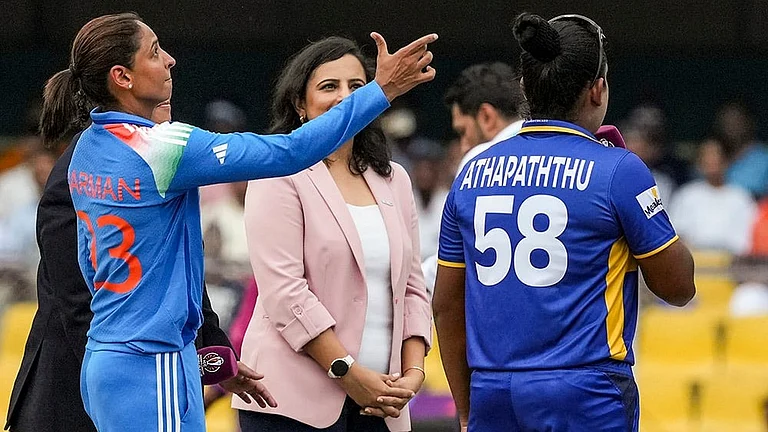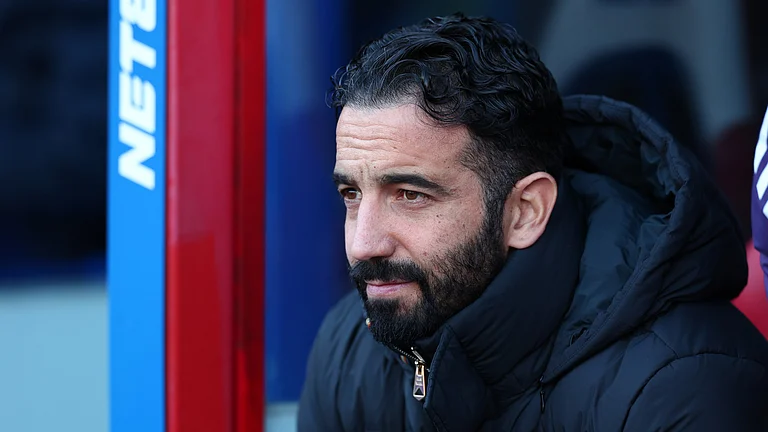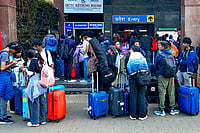Imagine the whole of humanity - indoors. Instead, butterflies fluttering across wide open roads in an Indian metropolis, blue skies over China, clear water and swarms of fish and swans back in Venice's canals! The new global mantra - stay at home - is having quite an unintended consequence. The world is seeing its arteries declogged after a long, long time, like a smoker who has just quit. But utopia will have to wait. The sense right now is of an impending apocalypse. It's sheer panic, and not love, that was making the world go round - or rather, stay still - on the Ides of March 2020. From Eiffel Tower to the Taj Mahal, from Euro2020 to the IPL, there was just one buzzphrase: 'flatten the curve'. The bio-tsunami breaking over our globalised landscape has emptied malls and pubs, hacked down the population density at bustling tech parks and divided humanity between conscientious self - quarantiners, manic hypochondriacs, and plain and simple maniacs who run away from isolation wards.
A new abbreviation, WFH, is all over. Work From Home isn’t a weekly or monthly amenity anymore—it’s the new normal for the foreseeable future. And people are rediscovering themselves. A big KJo family drama is unfolding in homes across Indian cities...call it Love in the Time of Corona.
It’s like an unofficial, self-imposed Section 144 over most of urban India. Yes, COVID-19 is still an urban disease: from its entry through gleaming, private-run airport terminals, it will percolate out to the hinterland via the city-village interface that unfolds every day, from the NRI and the phoren-returnee to the ATM guard, the Uber driver and the domestic help who flits between condominium towers and subhuman tenements. And we have scores of detective stories unravelling (in between a worldwide medical thriller that could put a Robin Cook in a trauma ward). Who all did the 18-year-old boy who returned from the UK to Calcutta on March 15 meet in his first 36 hours? His IAS mother and doctor father, instead of quarantining the son, threw a welcome party for him. And next day, he was taken for an impromptu tour of Nabanna, the state secretariat complex, by his bureaucrat mother, who, incredibly enough, later held a state-level meeting on coronavirus in those offices! A new kind of visual is being issued with urgency: patient flow charts, detailing every point in their itineraries, every place they visited. Between now-emptied cafes and the very many boxes from a week ago lined up in those flow charts may lie the story of a would-be Malthussian epidemic.
Yes, Malthussian. A world death toll of 45 million is being lobbed around as a possibility by academicians—if governments do nothing. How? That’s extrapolated from an Imperial College modelling of what can happen in the US and UK. Eighty per cent of Americans get infected, and four million die, in that scare scenario—“the whole population of LA”. Even if governments are reasonably proactive, the number is only halved. Health experts in India say finally 85 per cent of us will inevitably get infected. It’s only a question of when, and whether by that time vaccines and treatment protocols are in place. So tracking those flow charts is of paramount importance. That’s why Yuval Noah Harari, author of Sapiens, a 443-page ‘brief history’ of everything human, told CNN’s Christiane Amanpour that the end result will be massive and permanent surveillance states that will use biometrics and every other technological tool to track all of us each moment of our lives, long after Corona again becomes the name of a beer.
But that’s tomorrow’s nightmare. Today it’s a different battle, a new frontline everyday. Scientists across the world are poring over the virus’s genome sequence to find a way to tame the beast. Potential vaccine formulations—brewing in test tubes from Israel to Canada to a biotech firm in San Diego, and sundry world universities—have already sparked a debate between patenting and cheap access to the poor. In India, scientists under the aegis of ICMR-National Institute of Epidemiology have received DGCI approval for a drug combination (lopinavir, retonovir et al) as an “effective” ad-hoc measure—“we do not have time in this emergency situation,” one of the authors of the protocol told The New Indian Express. There’s another frontline: doctors, paramedics and others who are fighting the war blindfolded, and in the direct line of fire. We dedicate the following package to profiling some of these bravehearts.
But between science and the people, there’s that crucial intermediary: the government. It was the Imperial College report that curbed the schoolboy braggadocio of both Brexiteer Boris Johnson and the White House, and chastened them into a dead serious mode. (The US’s initial tardiness is blamed for the system shock it faces now; and the UK was forced to back out of its controversial ‘herd immunity’ idea, which rested on actually allowing everyone to be infected!)
Where does India stand? Are we really at Stage 2, where only the initial incoming cases from abroad and their contacts are infected, or have we crossed the frightening threshold to Stage 3, ‘community transmission’? If we don’t want to wait for an actual body count, the only way to know is through testing. The crucial debate is over that: who to test, how much to test? South Korea was testing upwards of 4,500 people in a million: some said that was excessive, even if that country had tamped down on its cases for now. India was hugging the other extreme: 3-in-a-million! And many attributed our low official COVID-19 count to the plain fact that we wouldn’t know if we haven’t tested. But on March 17, perhaps a week or two late, we finally had some signs of policy movement. The India Council for Medical Research (ICMR), besides roping in government institutes under the CSIR and DRDO, is now opening up testing to private labs, marking a shift to wider surveillance.
This phase will go beyond those first ones with a ‘virus visa’ and their primary contacts to a wider sample, explains Prof Gagandeep Kang of the Faridabad-based Translational Health Science and Technology Institute, and a Fellow of the Royal Society. “The idea is to start doing syndromic surveillance, which is what ICMR is doing...it is testing through its influenza network,” she says. If and when Stage 3 is actually reached, mass testing doesn’t add much information to the public health system and can be restricted to only the severe cases, she says. The ICMR says India is in Stage 2 and there’s no evidence of community transmission so far—that there’s still a window to contain an outbreak which seems inevitable. These are the moments when faith in the government and official data (which Harari mentioned as crucial) becomes crucial.
“The expert committee has given a revised protocol for COVID-19 testing,” ICMR chief Dr Balram Bhargava said on Tuesday. “We have scaled rapidly,” he added, explaining that the ICMR system has 72 functional labs and another 49 public labs will start by the end of the week—among these, two high throughput systems in two locations that can test up to 1,400 samples a day. Around 51 certified private labs will come on stream soon. And orders have been placed for a million probes—a key component of the polymerase chain reaction test that’s imported—while reagents and primes are at hand, he said. And the bare outline of a collective public-private endeavour is at last visible. “The modalities are being worked out,” Arvind Lal, chairman and managing director of Dr Lal Pathlabs, tells Outlook. “We have already approached our suppliers. Once we get the green signal from the government, within one week the tests will be up and ready.”
The WHO has been advocating a comprehensive approach. “Not testing alone. Not contact tracing alone. Not quarantine alone. Not social distancing alone. Do it all,” WHO director general Tedros Adhanom Ghebreyesus said this week. It has also been making appreciative noises about India’s efforts so far. The ‘efforts’ have also been somewhat easy to miss, with honourable variations visible in states like Kerala and, later, Karnataka. Logic tells us that while we make general statements like “India is at Stage 2”, the reality is different parts of India could be at different stages. There are hotspots, like the metros. And the spurt in positive cases over the past week has come from Maharashtra, Kerala, UP, Karnataka. By March 17, only 137 people had been diagnosed, of which three have died: all were foreign returnees and their primary contacts. But again, one presumes this has exhausted the personal map of all ‘contacts’. Valid presumption? Well, those Italian tourists in Jaipur had visited 23 tourist spots before testing positive.... After the first death, that of a 76-year old man from Karnataka’s Kalburgi, “we clamped down the entire district,” Karnataka minister for medical education D. Sudhakar said at a briefing. All contacts were traced and isolated, including four reporters who interviewed his son and are now under home quarantine. Scores across India with foreign travel history—among them Union minister V. Muralidharan and MP Suresh Prabhu—are in home quarantine. Maharashtra, which leads the positive cases tally, is now tagging people under self-quarantine with indelible ink.
But the air is thick with fear. Many are fretting about not being tested—including those with no travel history, like a Gurgaon resident holed up in his house who spoke to Outlook about calling every helpline possible (in vain) after developing flu symptoms post a Holi celebration with NRI friends. A Bangalore-based executive insisted on getting tested after disembarking from a Singapore flight last weekend because he had a cough, fever and body pain: he was taken in an ambulance from the tarmac to an isolation facility. “They recommended that I self-quarantine and come for a test only if the fever was in excess of 102 or if I was unable to breathe,” he told Outlook. Then, there are accounts about the questionable condition of some government-designated quarantine centres.
Meanwhile, the Section 144 virus too is global. Europe has closed its borders, and most countries have banned travel. Most airlines will be bankrupt by the end of May, says market intelligence firm CAPA. A techie who made it back to Bangalore from Germany on Sunday, days before the shutters closed, described to Outlook the unnerving experience of walking through empty airports. “I’ve never seen Frankfurt airport like that. Boarding was over in five minutes...only 35 passengers or so. Very scary.”
And so, life has turned into an indoor sport. Cities across India are in semi-lockdown: exams for most classes called off, colleges closed, malls, cinema halls, gyms and swimming pools shuttered. Bangalore’s roads, instead of looking like a bad ECG report, had set the clock back, incredulously, to a once languorous past. As people acclimatise to a degree of seclusion, many companies have switched over to work-from-home—daily meetings and shift handovers done through video calls or video chats, as one techie reveals, even if patchy internet connectivity does play up at times. In sectors where WFH isn’t feasible, there’s heightened alert. “Transport getting disinfected, people being checked before they enter a bus or a factory, canteens being monitored,” says Vikram Kirloskar, president, CII. “It’s a difficult situation. One has to be ultra careful and sensible.” Counting the losses will be for later.
As for politics, it doesn’t facilitate social distancing. Congress chevalier Digvijay Singh was seen in a jostling drama with the police in front of a hotel in Bangalore on Wednesday. And as of now, Ayodhya is going ahead with a mega Ram Navami mela, where lakhs could converge. “Ram will ensure no harm will come,” says Mahant Paramhans. That’s approximately where India is poised: between being literally ‘Ram bharose’ and having the option of being ‘too alarmist’, just in case.
ALSO READ


























